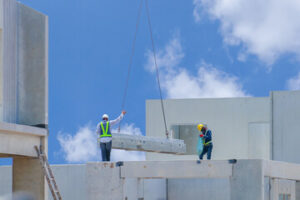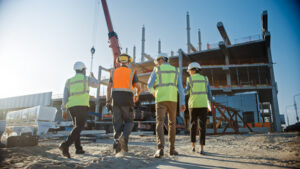Concrete lifting is a great way to restore sunken concrete slabs like sidewalks, driveways and patios without the expense of new concrete installation. Concrete lifting contractors drill strategically placed holes into the settled slab and then inject a stabilizing grout mixture or foam.

Mudjacking is an older type of concrete lifting that involves drilling holes and pumping mud or a stone slurry. This method is less effective than polyurethane foam.
Concrete lifting is a non-invasive way to level sunken or uneven concrete slabs, reducing the need for demolition and the need for new concrete to be poured. It can be completed within a few hours, meaning you can use the affected areas again immediately and without disruption.
Concrete slabs often become uneven over time due to environmental factors. Uneven surfaces aren’t just ugly, but they can also pose safety hazards for pedestrians and cause issues with water drainage. However, replacing these slabs is expensive and invasive.
While mudjacking involves injecting a heavy slurry of cement or stone under the concrete, the more modern method of concrete lifting uses polyurethane foam. It involves drilling small holes into the concrete surface and then pumping the foam through those holes. The foam expands under the concrete to fill voids and lift it back into place, but it is far less invasive than traditional methods of concrete lifting.
Unlike the concrete injected during concrete replacement, polyurethane foam is inert and won’t affect soil conditions underneath. It is also waterproof, protecting the concrete and helping to prevent future water erosion in the surrounding area.
Concrete lifting is not a suitable solution for severe damage to concrete, such as cracks or large chunks of broken concrete that have fallen out of place. These types of problems are better addressed by concrete replacement. But if your concrete is just beginning to settle, concrete lifting can help alleviate the problem and reduce trip hazards for pedestrians and drainage issues for homeowners. If you’re considering concrete lifting, it’s important to consult with a professional before deciding on the best option for your home.
Less Expensive
Concrete lifting can cost less than slab replacement because it doesn’t include the costs of demolition and rebuilding. Additionally, it’s an eco-friendly repair process that saves the original surface and fills the void underneath without using new materials. However, the cost of a concrete lifting job depends on how much the concrete needs to be lifted and whether it’s in a high-traffic area. For example, if the sunken concrete is in the front of your house where people walk and drive, it will need to be raised more than a slab in the back yard that is not used as frequently.
The type of foam used will also influence the price, as some are more effective than others. For instance, polyurethane injection is the best option for restoring uneven concrete surfaces like patios, driveways and sidewalks. Polyurethane is a durable material that lifts and stabilizes concrete surfaces to their original position and lasts longer than traditional concrete replacement methods.
Mudjacking is another common method of concrete raising, but it has several drawbacks that make it unsuitable for most residential and commercial applications. For one, it uses a water-based mixture that can be affected by changes in weather. In addition, mudjacking takes hours to set and may leave the concrete with unsightly marks on the surface.
If your sinking concrete is a safety concern or has caused drainage issues, you’ll want to have it repaired right away. Contact a concrete lifting specialist to learn more about your options and get an estimate for the cost of repairing your sunken concrete. If your budget is tight, you can try to reduce the amount that you need to lift by addressing any root causes of the problem, such as extending downspouts or rerouting drainage lines to avoid water accumulating in the soil under your concrete.
Less Disruptive
Concrete lifting is a less disruptive option than other methods for leveling concrete. This method can be completed in a matter of hours, which allows property owners to resume regular use of the area without significant disruptions or costly repairs. It can also save money compared to the cost of tearing out and pouring new concrete, making it a financially savvy choice for homeowners and business owners alike.
Concrete slabs are vital for residential and commercial properties, but they can become unlevel due to sinking or shifting soil conditions. When left unaddressed, these problems can lead to trip hazards and drainage issues on sidewalks, patios, or driveways. However, completely removing and replacing these structures can be expensive and a major inconvenience, especially if the damaged area is in a high-traffic location.
One alternative to complete replacement is concrete lifting, which raises sunken concrete surfaces back to their original position using expanding polyurethane foam. Contractors evaluate the affected areas to pinpoint where the concrete has sunk, and then drill holes into the slab. The foam is injected into the spaces between the broken pieces, creating pressure that slowly lifts the concrete back to its original position.
The repair process takes far less time than pouring a new slab, and it requires fewer materials. The concrete lifting method is also less expensive than mudjacking, and it can be more environmentally friendly than digging up and replacing a damaged concrete slab. It also provides a long-term solution for uneven or sunken concrete, which helps preserve the lifespan of existing infrastructure and minimizes the need for future repairs. In addition, the less-invasive repair technique can be used on a wide range of concrete structures, including basements and sidewalks.
Less Environmentally Hazardous
Concrete Lifting is a less environmentally hazardous option than other concrete repair methods because it saves the existing slab. Traditional concrete replacement involves removing the old slab, placing new concrete, and then waiting for it to cure. This method is resource-intensive and generates a lot of waste. Concrete lifting reduces the need for new materials and minimizes waste, lowering environmental impact.
Concrete lifting contractors drill small holes into the sunken or uneven slab, and then inject a specialized material under the concrete to raise it back to its original level. The new, lifted concrete is more stable and can be used immediately after the process is completed. This method is also less disruptive to surrounding landscaping than concrete replacement because it does not require the use of heavy equipment or truckloads of cement.
The concrete lifting material that is injected under the existing slab is lightweight, so it is not as invasive as other repair methods like mudjacking. Mudjacking is a more traditional repair technique, but it can be dangerous for workers due to the heavy concrete materials and machinery used.
Unlike other repair methods, the injected material used in concrete lifting is not toxic to the environment and does not affect groundwater or nearby plant life. This eco-friendly approach to repair is a welcome benefit for property owners who care about the sustainability of their homes.
Many factors cause the settlement of residential and commercial concrete, including improper soil compaction during construction, freeze-thaw cycles, and water damage. These factors are often unavoidable, but concrete lifting offers a way for homeowners to address settled concrete quickly and efficiently. This proactive approach to repair will prevent trip hazards and other safety concerns, and help preserve property values.
Less Curb Appeal Damage
A well-kept property is a huge asset to any homeowner, but it’s even more important to maintain your property’s curb appeal if you’re considering selling your home. Boosting your property’s curb appeal makes a great first impression on guests and passersby and is one of the best ways to increase the value of your home. Sunken concrete like settled sidewalk slabs, uneven front steps and heaved driveway panels is not only unsightly, but it creates serious tripping hazards that put you and your visitors at risk of injury. Concrete lifting lifts and restores these high-traffic areas, eliminating tripping hazards and improving your property’s appearance.
Concrete sinking is often caused by underlying issues such as soil erosion, improper compaction and moisture changes. Patching the surface can cause further damage if the root of the problem is not addressed. Concrete lifting addresses the underlying causes of sinking concrete by raising and stabilizing the concrete surfaces to their original position. This repair method is the most cost-effective and durable solution to restore high traffic areas and protect your property’s value.
With minimal disruption, professional concrete lifting can be completed in a day or less. This process safeguards surrounding landscaping from damage and leaves your property looking better than before. This proactive approach to repairing sunken concrete prevents larger repairs in the future, saving you time and money. Contact a reputable concrete lift specialist to request a quote and find out more about this effective, affordable and sustainable repair option. You can expect a quick, free estimate and expert advice from a team dedicated to delivering superior results. For your convenience, we also provide financing options to qualified applicants.
